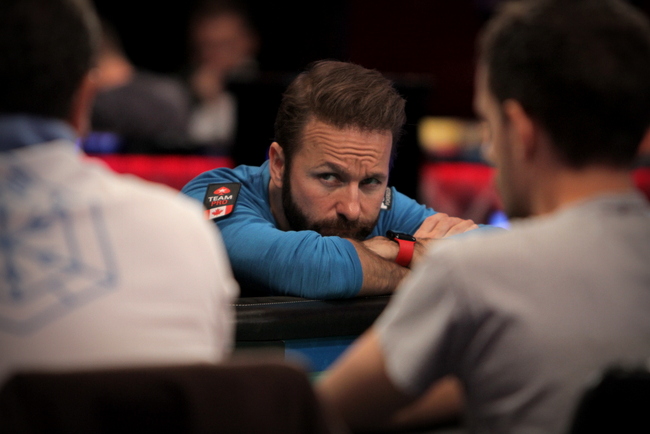Daniel Negreanu’s Strategy Tips for Modern Tournament Poker
If you entered the poker tournament world 10 years ago, you know there were a few pretty simple strategies employed. That’s not the case anymore. All-time poker icon Daniel Negreanu takes us through his Strategy Tips for Modern Tournament Poker in 2021.
-
T&Cs Apply | Play Responsibly | GambleAware
18+ | Play Responsibly | T&C Apply
-
T&Cs Apply | Play Responsibly | GambleAware
T&Cs Apply | Play Responsibly | GambleAware
Tournament poker strategy has advanced in leaps and bounds over the past decade. And an “old-school” style will no longer cut it at the poker tournament tables. In modern tournament poker playing styles, bet-sizing and the general approach to specific situations have all changed drastically. Recently jumped back into tournament poker or are a bit lost with strategy in tournament poker in 2021? We’ve got some tips for you from one of poker’s all-time tournament money winners – Daniel Negreanu.
How to Play the Early Stages of MTTs
Daniel Negreanu: In the early stages of many tournaments there is no ante. This forces you to play very conservative. I’m a big believer in the saying that you can’t win a tournament in the early stages but you can lose it. If you can identify a player as weak, particularly post-flop, you want to play more hands against them. And exploit that by trying to take pots from them on the flop.
It’s true that you have a lot of big blinds so you can theoretically afford to limp a lot. But, I don’t think you see good players do that. There isn’t a lot of limping. Because essentially, if you limp, you give the small and big blind the chance to realize their full equity. Allowing them to see flops with 9-6 off-suit or 9-2 off-suit.
Although raise-sizes are so small today that they’re almost like a limp. So you eliminate these hands and that’s a fundamentally better way to play. But as a general rule you should not be concerned about increasing your stack by 20-30% in the first couple of levels but rather try to keep what you have.
Related Reading:
- A Dead Simple Guide to Poker MTT Strategy
- 4 instructional tournament hands in our Online Poker Tournament Tricks (2021 edition with Jesper Hougaard)
Scenario 1: You get involved in a big pot in the early stages of a tournament. You win that pot and find yourself in the top 20 of the leaderboard. Do you proceed cautiously or do you now try to constantly put pressure on the other players?
Daniel Negreanu: In the early stages of an MTT you don’t have a lot of ICM pressure. There’s no bubble to get across. And there are almost no players who have really short stacks. So, realistically, the big-pot win early on doesn’t really change the way you should play.
If you play 200 big blinds in the beginning of a tournament and somehow you go up to 350 or 400 big blinds, that doesn’t really matter.
Where it matters is when you have several players at your table that are down to 30 big blinds or less in a later stage. Then you can start bullying them around because every decision for them is now about money. The difference between 200 and 400 big blinds is mostly irrelevant outside the fact that you can lose an all-in and still survive.
Scenario 2: You get involved in a big pot in the early stages of a tournament. You lose that pot and find yourself in the bottom of the leaderboard with 20 to 25 big blinds.
Daniel Negreanu: In this scenario you’ve just lost the ability to play deep-stack poker. So now you have to adapt and switch to Plan B, which is a fundamentally more conservative style of play. You’re now looking for spots to double up, contrary to a 200 big blind stack which you won’t try to get in to double up.
How to Play the Bubble Phase of an MTT
For years the bubble phase of a tournament – meaning the approach of the money spots – was the phase where you tried to exploit the smaller stacks as viciously as possible by permanently attacking them. Is this approach still valid?
Daniel Negreanu: Many players over-emphasize the bubble phase. It’s not really that big of a deal unless you’re really, really short.
If you are very short you have to estimate how much longer you can wait, how many chips you can give up by folding good hands to get into the money and win the min cash.
Your strategy depends entirely on your stack size. If you do have a big stack then, yes, you should still try to take advantage of that situation. But having said that I don’t think it makes a lot of sense to play like a mad person in that situation because you don’t want to jeopardize your stack either by playing foolishly.
Related Reading:
How Do You Size Your Bets?
Daniel Negreanu: Bet-sizing is extremely important and has changed drastically since I started playing.
People came out raising 3 times or 4 times the big blind, minimum. Pot-sized bets on the flop were the rule and not the exception. This is why I developed the strategy known as “small-ball poker.” It means that you size your bets much smaller to give yourself the chance to play many more hands.
If you look at High Roller tournaments and how they’ve developed in the last 18-24 months, you see a lot of small pre-flop raises and small bets on the flop. But then on the turns and rivers we see 2x or 3x the pot bets. Huge over-bets to put as much pressure as possible on the other players. And this is poker on the highest levels so this shows you the way to go.
More generally speaking, your bet-size depends on the flop texture. Plus, the size of your stack in relation to the pot and the range you put your opponent on. The over-bet is your weapon in polarized situations when you either have a very strong hand or nothing. That’s when you bet two times the pot to make it difficult for your opponent.
Small ball poker is now essentially the fabric that every good poker player uses. But this refers mainly to pre-flop and flop play. Flop bets today tend to be a quarter to a third of the pot whereas in the old days it used to be three quarters to full pot.
Turns and rivers are now where the game gets interesting. That’s where there’s now a lot of room to adapt and exploit – bet-sizing on turn and river. You can see that we see less and less half-pot bets. It’s either small bets or often very big bets.
How to Play the Late Stages of an MTT
Scenario 3: You’re in the top third of the leaderboard. You get moved to a new table. You raise with pocket kings from middle position and get a call from a player in the blinds who has you slightly covered. On the flop the situation is as follows.
- Your hand:
K
K K
K
- Flop:
K
K 9
9 8
8
Your opponent checks, you bet small and get raised. What do you do?
Daniel Negreanu: In this situation you should usually call, unless you think they have a strong hand they want to go with. But, as there’s a chance they might be bluffing, I want to give them the chance to bluff again. Pushing all-in would not be very smart even though you have the best hand at the moment. Yes, you’ll occasionally get value from drawing hands. But by calling you’ll accomplish one of two things.
- If the draw doesn’t come in you can pick off any bluff and call any bet.
- If the draws come in you can minimize your loss. Say the T♠ comes on the turn, you can play more cautiously. With your hand you block the king so your opponent will either have a lower set or a flush if he check-raises the flop and bets turn and river.
You might even fold your three kings. Also at this stage you have to think about what you would do with your entire range. If you call the check-raise with just a king or a nine or even a gutshot, you have to have a set of kings in your calling range, too. If you don’t, you become too easy to exploit.
Your play in that situation changes if you don’t have position. Out of position you would often re-raise on the flop because if you don’t your opponent is likely to check back the turn if he misses. And that would mean you miss out on a lot of value.
Related Reading:
Related Poker Strategy Articles
- Daniel Negreanu’s 7 Golden Rules for Poker Beginners
- How to Survive Big-Field Poker Tournaments
- Poker Workshop: Think Your Way to Better Tournament Decisions
- 7 Simple Ways to Get Better Results in Poker Tournaments
More on Poker Tournaments
-
Stake.US Poker4.3
- Rakeback 5%
- $55 Stake Cash + 260K Gold Coins
T&Cs Apply | Play Responsibly | GambleAware
18+ | Play Responsibly | T&C Apply
-
Appeak Poker4.1
- 1,000 Chips Daily
- FREE 5,000 Chips
T&Cs Apply | Play Responsibly | GambleAware
T&Cs Apply | Play Responsibly | GambleAware
-
- 150% up to 25 SC
T&Cs Apply | Play Responsibly | GambleAware
Terms & Conditions apply
-
- 5%
- 200% Gold on 1st Purchase
T&Cs Apply | Play Responsibly | GambleAware
Terms & Conditions apply
-
- 2,500 Gold Coins + 0.50 Sweeps Coins
T&Cs Apply | Play Responsibly | GambleAware
18+ | Play Responsibly | T&C Apply






User Comments
Great Tournament Information from Daniel! He rocks!